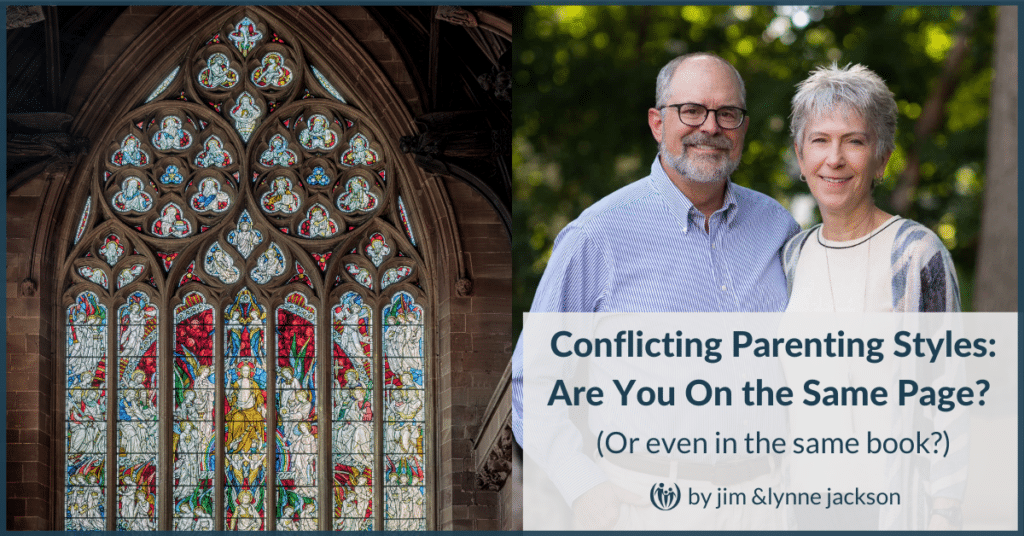
Conflicting Parenting Styles: Are You On the Same Page?

When we meet parents with conflicting parenting styles or who disagree about parenting, they often talk about wanting to get “on the same page.” This can be a tall order. We know it was for us.
While we shared core values, faith, and common interests, we quickly learned that we were quite different. The gifts we admired in each other at the beginning of our relationship are what we longed for in ourselves and for our family. But those differences quickly become the source of misunderstanding and conflict. Not only were we often not on the same parenting page, but we were sometimes in totally different books!
Jim: I was immediately attracted to Lynne’s vibrant presence and ability to quickly get to the heart of things (not to mention her striking blue eyes!). Lynne’s sweet spot for creating order, consistency, and systems for getting things done helped keep my abstract random tendencies on track. Echoing the famous line from “As Good as It Gets,” I agreed with Jack Nicholson’s character when he said, “She makes me want to be a better man.”
Lynne: Jim’s spontaneity, comfort with messes, and fun-loving approach to challenges seemed a perfect match for my tendency to take life a bit too seriously. Even as I write this, he is singing and chatting while making our coffee! This trait has always made it more natural for me to lighten up and get through things with joy. That he so quickly eased tension with lightness seemed a very appealing compliment to my focused work ethic. (My grandmother’s last name was Kraut, and German farm-girl ethic was “strong in this one.”)
Opposites attract, right? We were smitten. With high optimism, we lunged into marriage and became parents a year later.
Conflicting parenting styles led to polarized parenting roles
Five years and three kids later, our opposite personalities caused more struggle than attraction. By ten years in, our marriage was suffering.
Lynne: My vigilance about schedules to keep, messes to clean, and laundry to do pitted me against Jim’s tendency to play with the kids when I thought he should be guiding them toward responsibilities.
Jim: I’d come home from work looking for light connective time with the family, but instead, I usually got enlisted in an earnest effort to herd kids toward chores, homework, or dinner. Rather than supporting Lynne’s efforts, I’d often become a distraction that threw her plans off course.
We found ourselves sliding into polarized “Fun-meister vs. Task-master” roles. These roles pitted us against each other instead of spurring us to build on each other’s strengths as teammates.
While we had a deep and abiding commitment to each other and a shared vision for the kind of family we wanted to be, the surface issues rooted in our differences gained power as resentment festered. We grew more distant from each other, even to the point of starting to feel attraction for others. (You can read more about when this happened from Jim’s perspective and Lynne’s perspective.)
Talking it out?
We had attended marriage courses, read marriage books, and even done some counseling along the way. We knew we needed to talk this out. However, efforts to communicate about our differences and needs frequently ended in frustration or worse. It was like the core of who each of us were was being judged and rejected. We were losing the joy of being married.
Something had to change, and it wasn’t about just getting over it or trying harder. A fundamental perspective change was needed.
From our work coaching many parents who struggle with similar dichotomies, we now know that this is a common issue. As we struggled, we each agreed to look inward toward our own misdeeds and selfish attitudes. It turns out that it is extremely humbling and simultaneously freeing to look at “the logs in our own eyes” ahead of the “specks in our spouse’s eyes.”
The changing point: a new paradigm
Jim: As I looked inward, I had to confess that my marriage expectations were unrealistic. The multi-faceted fantasy I held was that Lynne should be so many things that she was not. This had me focused on what I perceived to be her flaws. The more I dwelt there, the more my disappointment deepened.
Aware of this, my prayer one day was, “Lord, give me your eyes for Lynne. Help me to see the beauty of all she brings to our family.” As I prayed, I felt like God spoke directly to me through a new insight. “Lynne is not the wife of my dreams. She is the wife of my reality.” I immediately felt free to give my best energy and attention to Lynne’s many strengths. I could see that our family – especially our kids, but me too, needed her persistence and focus.
Lynne: As you might imagine, I was a bit taken aback when Jim first suggested that I was the wife of his reality, not of his dreams. I remember thinking, “I can either be really discouraged by that or really relieved.” The latter seemed much more appealing! 😉 I felt strangely freed from the expectations to measure up to the previous standard of being a cheerful, joyful organizer who also had a good measure of spontaneity and fun.
With this new perspective and freedom, it was easier to receive God’s encouragement about who I was.
Another turning point for me came one day on a prayer retreat. I was in a church with an intricate stained glass window, and the carpet glowed with beautiful patterns of light. It struck me: How boring it would be if all the pieces were the same color! I imagined that Jim was the bright, energetic red in the design, and I was the rich turquoise – very different, not as intense, but beautifully complementary as the light of Christ shone through us.
God has placed the parts in the body, every one of them, just as He wanted them to be. If they were all one part, where would the body be? As it is, there are many parts, but one body. 1 Corinthians 12:18b-20
Jim bought me a turquoise cross necklace that summer, and our little daughter Bethany even bought me turquoise earrings to celebrate that realization. I began to fully embrace my unique “turquoise-ness” (my focus and love for order) and how God had placed me in our noisy, disorganized family as a gift.
Jim: As I learned to let go of the dream of Lynne being a wife who is always happy, fun-loving, and eager to serve, the pressure was off. As I embraced that she was the wife of my reality, I found new freedom to love her not just as she is but to value the beauty of our differences. I then almost miraculously began to appreciate and be attentive to her needs, and she to mine!
Like a dream come true after all!
Each of us owned responsibility for ourselves, and only ourselves
Essentially, what changed back then (and is still changing in us today) is that we each committed to first pointing the finger of responsibility at ourselves in our own way. Conflict is usually “my sin running into someone else’s sin,” and I’m only responsible for mine.
This probably isn’t a natural default for anyone, and we’re still learning after all these years to walk in it. If either of us keeps the “I blame you” attitude for long, our commitment reminds us to shake it out and try again. We laugh at ourselves more – even in our conflict. As a result, we keep growing more and more in love as we appreciate new aspects of the unique ways we’re each made.
If you can’t agree on parenting, take some time to reflect on the gifts each of you bring
It’s challenging when you fall into polarized parenting roles, but chances are, each of you brings something important to your children. When you disagree, it’s likely because each of you is trying to protect the unique gifts that you bring to your parenting.
Joy and connection have always been a wonderful gift and value for Jim, and that had felt threatened. Lynne was protecting a desire to grow responsibility in our ADHD kids so they wouldn’t miss elements of God’s calling for them. These were both good things!
Looking back, we realize that conflicting parenting styles are often symptoms of conflicting parenting strengths. Take some time to identify what those parenting strengths are for both you and your spouse.
Here are some questions to ask yourself if you want to dig a little deeper:
- What does your spouse or co-parent bring to the mix, and how is that a valuable contribution?
- What are the unique traits that you bring to your family? In what ways are those characteristics a valuable contribution?
- How might you best use your unique gifts to benefit your family and God’s purposes?
Next time you’re in an argument that just doesn’t seem to get anywhere, remember that it’s likely that your figurative (or maybe even literal) finger is pointing at your spouse. Imagine yourself thoughtfully turning it to yourself to gain insight. And then remember, both of you provide an essential color in the beautiful stained-glass mosaic, which is your marriage and family.
© 2015, 2024 Connected Families

Stop believing lies.
About you. Or your kids.
Learn to approach motherhood with grace and truth. Take the Grace & Truth for Moms small group course.

